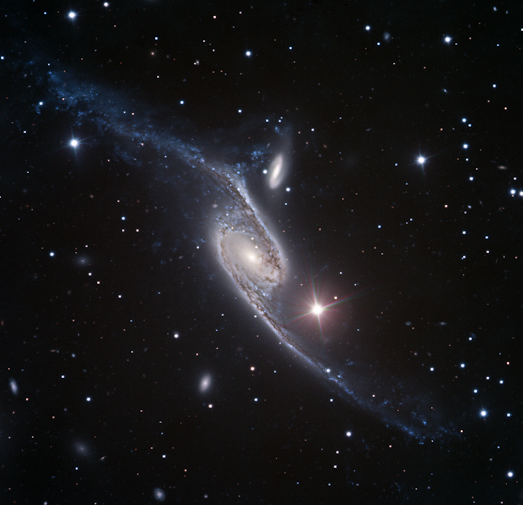Gazing into the vast expanse of the universe, our eyes can land on truly awe-inspiring objects. One such marvel is NGC 6872, also known as the Condor Galaxy. Buckle up, space explorers, because we're about to embark on a journey to unravel the mysteries of this celestial giant.
A Staggering Distance and Ancient Origins
NGC 6872 resides a staggering 212 million light-years away, a testament to the mind-boggling scale of the cosmos. Estimated to be roughly 5 billion years old, this majestic spiral galaxy has been weaving its story in the grand tapestry of the universe for eons.
A Colossal Structure: Size Matters in Space
NGC 6872 boasts an awe-inspiring size. When measured by the ultraviolet light it emits, its diameter stretches over 522,000 light-years. But that's not all! Using a different measurement technique, astronomers estimate an even more mind-blowing diameter – over 717,000 light-years – making it the undisputed champion among known spiral galaxies.
The sheer mass of NGC 6872 is likely in the hundreds of billions of suns, harboring countless stars within its swirling arms. However, pinpointing the exact number and types of stars remains an ongoing quest for astronomers.
A Dance of Creation: Star Birth Fueled by Interaction
NGC 6872 isn't alone in its cosmic ballet. It's locked in a gravitational interaction with its smaller neighbor, the lenticular galaxy IC 4970. This intimate dance, though not a full-blown collision, has a dramatic effect on NGC 6872. The pull of IC 4970 has triggered bursts of star formation within the Condor Galaxy's spiral arms, particularly the northeastern arm. This stellar nursery might even be responsible for the formation of a curious object – a bright ultraviolet source at the arm's tip, possibly a tidal dwarf galaxy, a by-product of the gravitational interaction.
A Look at the Neighbors: The Supporting Cast
IC 4970, NGC 6872's companion, is a lenticular galaxy. Unlike its grand spiral neighbor, IC 4970 has a prominent bulge but lacks well-defined spiral arms. It's significantly smaller, with a mass roughly one-twelfth that of NGC 6872.
A Galactic Saga: A History Etched in Stars
The discovery of NGC 6872 is credited to John Herschel in 1835. But the galaxy's story stretches far beyond that. Its immense size and ongoing interaction with IC 4970 make it a unique object in the cosmic menagerie. Such interactions play a crucial role in galactic evolution, triggering star formation and potentially leading to the birth of entirely new galaxies.
A Universe in Motion: A Future Filled with Encounters
The current tango with IC 4970 is likely the most prominent recent event in NGC 6872's history. However, galaxies are constantly on the move, and NGC 6872 has undoubtedly interacted with others in its long life, shaping its current form. As the universe continues to evolve, future interactions are inevitable, and these encounters will continue to sculpt the Condor Galaxy's structure and star formation.
A Gateway to Further Exploration
Our exploration of NGC 6872 is just beginning. By delving into research papers available through online scientific databases, you can embark on a deeper dive into this fascinating celestial giant. The universe holds countless secrets waiting to be unraveled, and NGC 6872 is just one chapter in this ongoing story of cosmic wonder.

Comments
Post a Comment